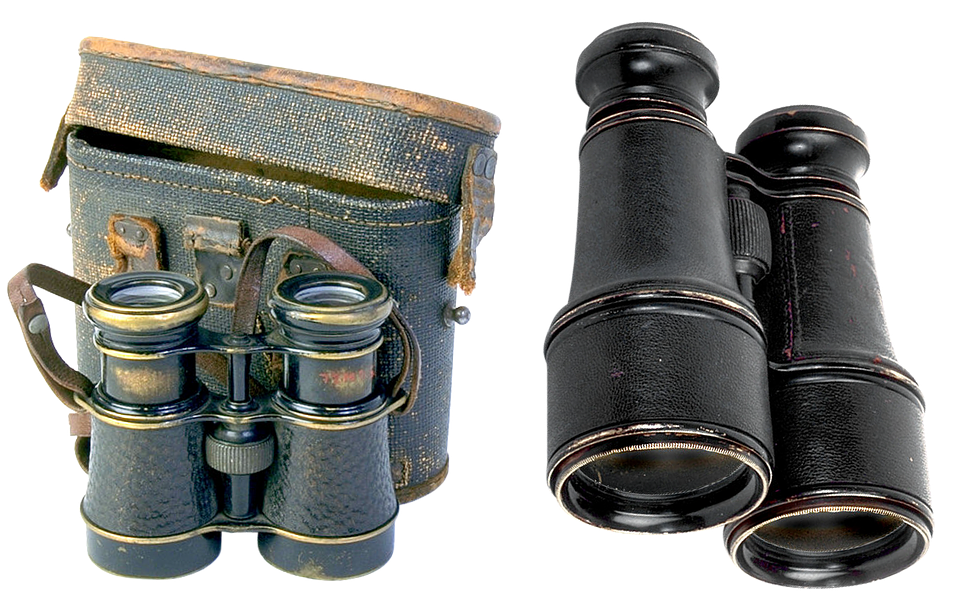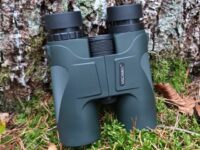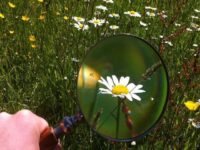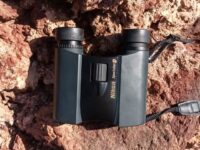Binoculars Glossary
There are a lot of special terms and lingo when it comes to binoculars and telescopes. Understanding the technical terms helps to understand how binoculars work and to assess the quality of optical instruments.
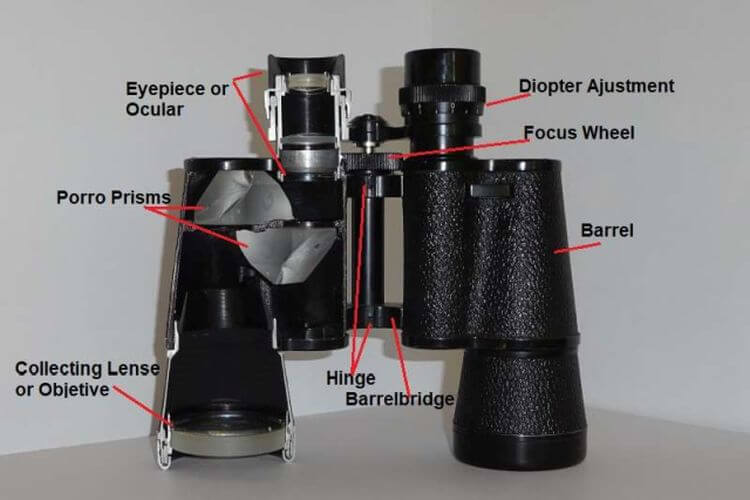
Find the most common terminology in this brief binoculars glossary:
Aberration
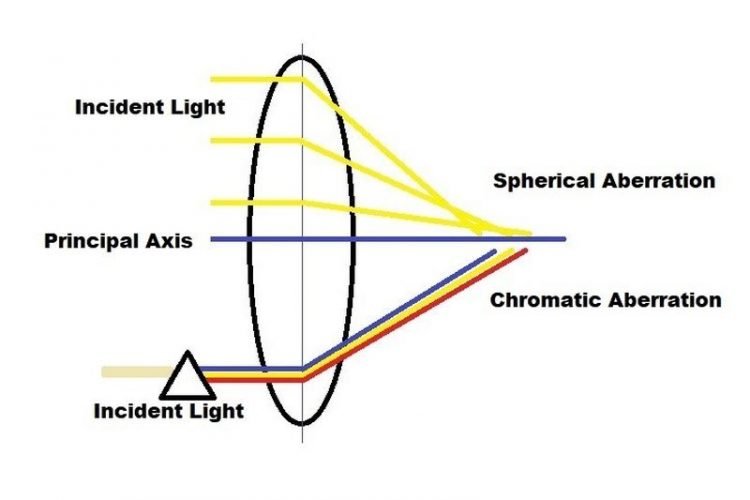 These are errors that occur in optical systems due to the natural laws of how light behaves when it passes through various media. Light of different wavelengths and colors is refracted to different degrees when passing through lenses.
These are errors that occur in optical systems due to the natural laws of how light behaves when it passes through various media. Light of different wavelengths and colors is refracted to different degrees when passing through lenses.
Spherical aberration creates edge blur, which appears in the decrease in sharpness near the edge area of the image. Chromatic aberration shows up as color fringes on the edges of light / dark transitions.
Coating

When light hits a glass surface, part of the incident light is reflected. This also happens when the light beam emerges from the glass. With the many lenses in binoculars, this loss of light adds up, and the images lose brightness, clarity, and contrast. There may also be disturbing reflections and ghosting.
These reflection losses can be minimized by special coatings that are vapor-deposited onto the glass surfaces, thus more light passes through the optical instrument. The coatings increase transmission.
Close Range Focus
Minimum Focus Distance, the shortest distance that binoculars can focus on an object. Roof-prism glasses are better in this aspect than Porro prism glasses. The best roof prism bino can be focused on objects just under 6 feet (2m).
Diopter adjustment
Corrects the different visual strengths of both eyes. Spectacle wearers should try to balance the different eyesight with the binoculars. Use the diopter adjustment as follows:
-Use the left eye to aim at the target (right eye closed) and turn the central focusing wheel until in focus.
-Now use the right eye (left eye closed) and turn the diopter adjustment on the right ocular tube until the image is focused. Done, now only the center focus is used – until another one uses the scope.
Distortion
Distortion in optics is the curved appearance of straight lines in the observed images, because of an uneven magnification in the field of vision. In binoculars, this distortion is increasingly visible closer to the edge of the image. A distinction is made between barrel distortion (magnification decreases near the edge), pincushion distortion (magnification increases near the edge), and mustache distortion (a mixture of both types of distortion).
Eyecups
They ensure the correct distance to the eyepiece. Spectacle wearers correct simple visual defects with the binoculars. The glasses should only be used if the diopter compensation on the binos does not work.
Exit Pupil
This is the diameter of the light beam which leaves the binoculars or telescope at the ocular (eyepiece). The exit pupil is the quotient of aperture diameter by the magnification.
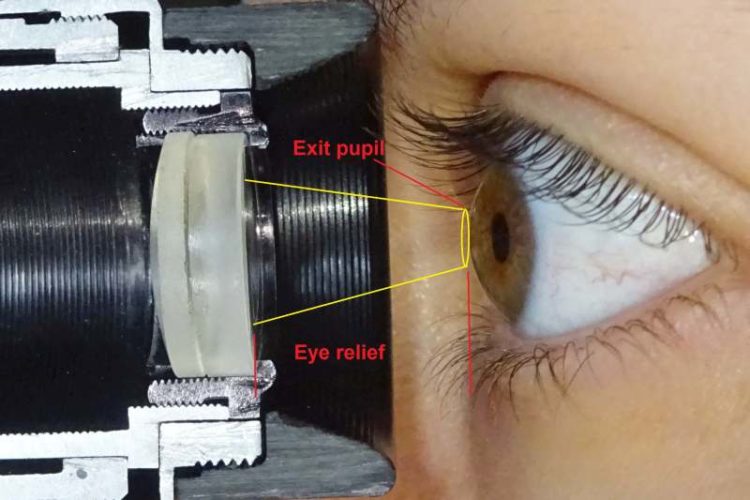
Eye Relief
The distance between the ocular lens and your eye’s pupil is called eye relief. At this distance, the maximum field of view can be comfortably observed.
Field of View
This is the horizontal width of the image you see when looking through the binoculars. Usually, this is a value in feet (meters) of the width of the area at a distance of 1,000 yards (or 1,000 m). In simple terms: the smaller the field of view = the larger the magnification.

Focus Wheel
The central wheel adjusts a blurry image to become focused. Turning the central focus wheel slightly changes the distance between the ocular lens and the objective lens until the image is in Focus.
Fog proof
The air inside the instrument is replaced by a gas filling and it is sealed to prevent moisture from entering, preventing internal fogging and fungi growth.
Gas filling
High-quality glasses are filled with Nitrogen or Argon gas. The absence of normal air and humidity inside the instrument prevents condensation and fogging, thus allowing use in extreme temperature fluctuations and reducing the risk of lens fungus.
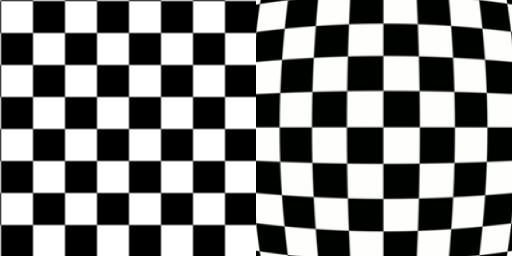
Globe effect
Aka rolling ball effect. This phenomenon appears when panning the binoculars horizontally, creating the impression that the image bulges out in the middle.
The image appears curved as if looking at a ball from above.
Kidney Bean Effect
Revers to the oval shadows that appear at the edge of the image field. The technical term is “Vignetting”, see below.
Lens Distance
The further the objective lenses are apart, the more “three-dimensional” becomes the viewing experience. Porro prism glasses are superior to roof-edge binoculars in this aspect
Magnification
The magnification (or power) refers to the degree at which the image you are viewing is enlarged. For example, a 10x42 binocular magnifies the image 10 times or in other words, an object that is 1000 yards away, appears only to be 100 yards away.
Opening
Or Aperture is the diameter of the objective lens. Specs 8x42 refers to an objective of 42 mm diameter. The larger the aperture the more light is collected and the scope becomes more suitable for uses in low light conditions. Night glasses or stargazing binoculars usually have apertures of 50 mm upwards.
Prisms
Prisms made of high-quality glass are located inside the tube of the binoculars for two purposes. They correct an inverted image so the world is not upside down. They also increase the focal length while reducing the overall length of the instrument. (Longer focal length will allow for higher magnification). There are two types of prisms used in binoculars, Porro prisms, and Roof prisms. Porro Prisms give binoculars the typical two-stage profile, while Roof Prisms produce a straight optical channel.
Transmission
This value is used in relation to the brightness of the viewed image. It indicates the percentage of how much of the incident light leaving the eyepiece after passing through the entire binoculars. The more glass the light has to pass through, the weaker it becomes because glass absorbs and reflects light.
High-quality homogeneous glass quality and coating of the glass surfaces optimize the transmission and reduce the reflections. The top transmission values of high-end optics are over 90%. This distinguishes the really good glasses from the simple ones.
Twilight Factor
A calculated value of how binoculars perform in low light. Twilight Factor is the square root of the product of lens diameter by magnifying. e.g. :
TF = √8 x 32 = √256
TF = 16
However, how well binoculars work in twilight depends also on: light transmission (values over 90 percent are possible), optical lens coatings, size of the aperture (the more, the better), and the size of the exit pupil.
Vignetting
Vignetting is a shadowing of the image towards the edge. This is also known as the “kidney bean effect”. This occurs when the view into the optics is not exactly centered, i.e. when the eye deviates too far from the optical axis. If the eye relief is very long this effect is more likely to occur. It can be avoided by holding the binoculars so that the eyes are positioned as close as possible to the eye relief.
Weight
Heavy glasses are more steady in the observer’s hand and allow for concentrated observation of details. However, they may be tiring after a while.
